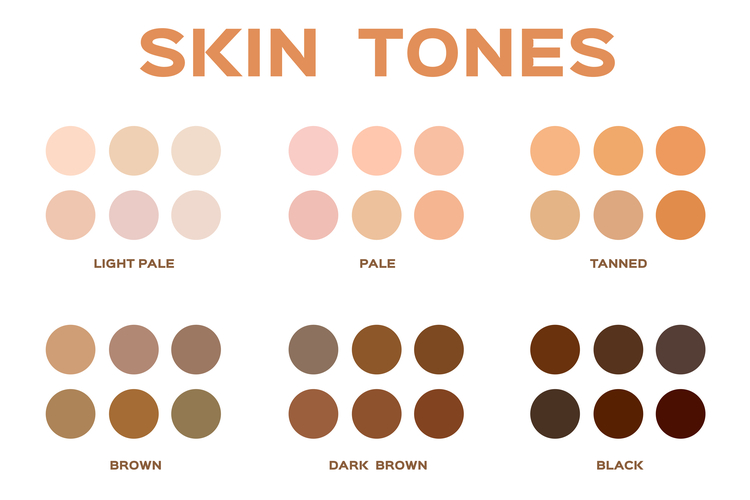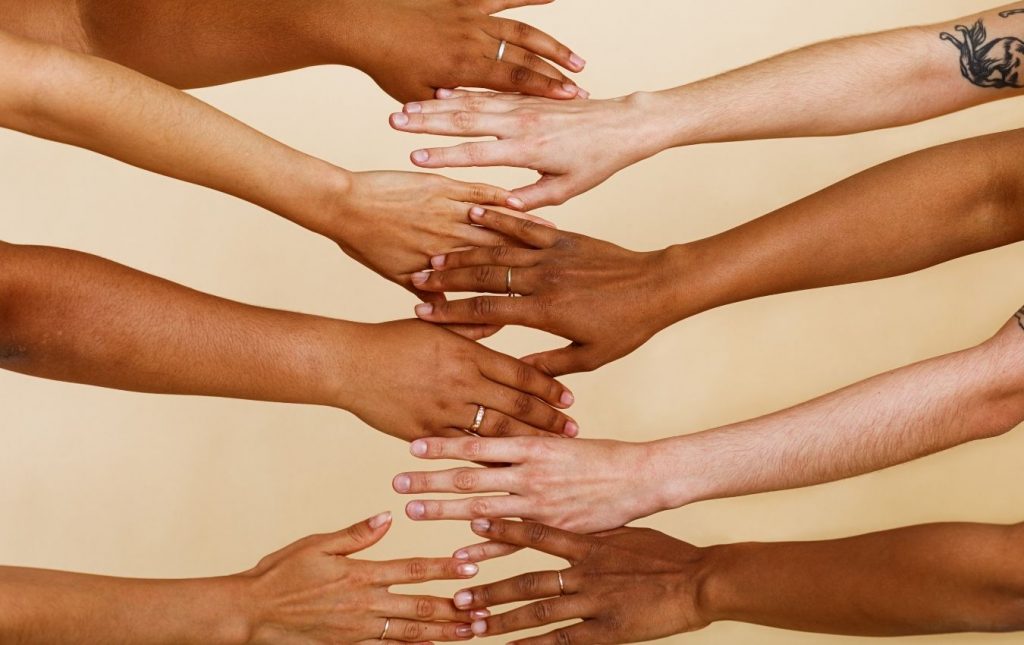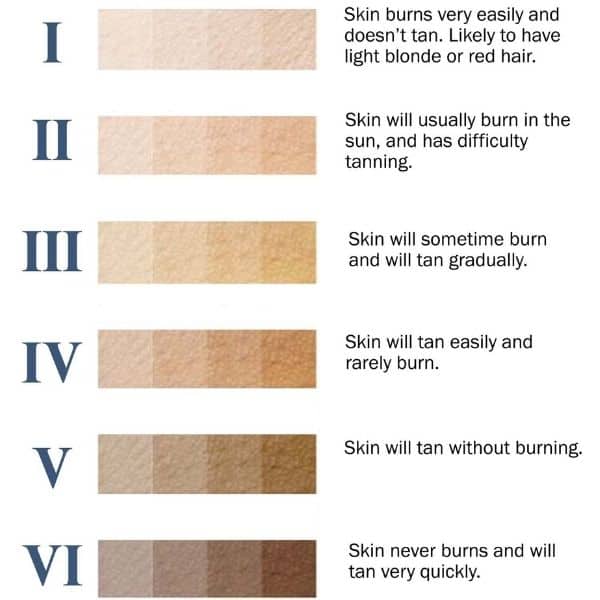As humans, we come in all different shapes and sizes. Our skin tone is no exception. The good news is that there is a skin tone chart to help us determine our skin type, color, and undertones.
Designers, stylists, and color consultants use this chart to help them determine the best colors for people’s skin tones. But you don’t need to be a fashion guru to use this tool.
This guide is designed so everyone can get an idea of what colors look best on their unique skin tone. All you need to do is follow the simple steps below.
What Is Skin Tone?
The tone of the epidermis is determined by genetics. Melanin is the pigment responsible for skin tone. Skin tones vary from light to dark depending on how much melanin a person has in their epidermis, hair, or eyes. It’s what gives us our natural tones, and when we get sun exposure, melanin reacts to create a tanning effect.
Skin tone can also change over time due to age, hormones, medication use, stress levels, and other factors that bring about hormonal changes. There are three main types of skin tones that fall into three categories- light, medium, and dark.
Light skin tones:
Your skin tone determines how you should protect yourself when in the sun. If your skin color is light or fair, your ancestors likely came from northern European countries where there was less sun exposure due to frequent snow or cloud cover.
This means people with cooler tones are usually susceptible to the sun and burn much easier than those with darker skin tones. It also means they need extra protection, like wearing sunscreen every day under their makeup for longer-lasting UV defense against all types of rays (UVA, UVB).
Medium Skin Tone/Olive Skin Tone
Medium complexions are typical of Southern Europe and Northern Asian descent. Sometimes referred to as “olive,” this skin tone is a neutral, well-balanced beige appearance that will make finding the right foundation shade much easier.
If you determine this is your skin tone, you probably tan in the sun (note: that doesn’t mean you’re immune to sun-related aging!).
Dark Skin Tones
People with a dark skin tone have more melanin in their skin. This makes their skin darker than people with a light skin tone. Darker skin tones are generally found in people who have ancestors from Africa, the Middle East, or Asia. Indian descent is typically an olive skin tone.
Skin Tone Chart
Simply find your skin tone on the chart and follow the corresponding instructions.

How To Determine Your Skin Tone
Actual skin tone varies from person to person and is dependent on your unique undertone. Skin’s undertones refer to the shade of your complexion, whether it’s cool (pink), warm (yellow), or neutral (skin-colored). Different shades of your skin undertone influence the colors that suit you best.
Skin’s undertone will ultimately determine if you’re a red-orange, blue-green, or yellow-gold person. Continue reading to discover how to determine your skin undertone.
Skin Tone Chart For Determining Your Undertones
Skin tone charts are helpful, but they don’t always show all the different undertones. That’s why it’s important to be able to determine your skin tone and figure out the undertone you have as well.
The skin tone chart below shows the most common skin types and skin undertones. There are three undertones:
- Cool Undertones – Pink, red or bluish based
- Warm Undertones – Yellow, peach, or golden based
- Neutral Undertones – No real color, greige or roughly gray-brown skin color
More: ALABASTER SKIN – EVERYTHING YOU NEED TO KNOW

Cool Skin Undertone
People with cool skin undertones tend to have pinkish or blue-tinged skin, and they usually have hazel, green, or light brown eyes and silver, ash blonde, or black natural hair color. Cool skin tones make up about 20 percent of the population.
If you have cooler undertones, you’ll want to choose colors that are soft and muted, such as pinks, blues, grays, purples, and lavenders. These colors look best against a background of dark neutral tones such as charcoal or navy. Bright cool colors such as fuchsia or citron green aren’t recommended.
Warm Skin Undertone
People with warm undertones tend to have yellow, peach, or golden skin. They usually have green, brown, or hazel eyes and reddish hair. Warm skin tones are the most common, making up about 70 percent of the population.
If you have a warm undertone, you’ll want to choose rich and warm colors, such as golds, reds, oranges, beige, yellow-greens, and dark brown. These colors look best against a background of light neutral tones such as bisque or taupe.
Soft, warm colors such as lavender, dusty rose, or olive aren’t recommended.
Olive Undertones (Brown)
People with olive undertones tend to have brown skin and dark hair, eyes, and eyebrows.
If you have an olive tone, you’ll want to choose deep and rich colors such as maroon, forest green, emerald green, rust, orange-red, and deep browns. These colors look best against a background of black or very dark brown. Colors that are too bright or light, such as pastels and beige, should be avoided.
Neutral Skin Undertone
People with neutral undertones have a mix of warm and cool tones, and they usually have blue or green eyes and light brown, ash blonde, dark blonde, or black hair. About 10 percent of the population has neutral skin undertones.
You can wear any color you like if you have a neutral undertone! However, if you have a light neutral skin tone, you should avoid wearing too dark or bright colors because these colors will make your skin appear washed out.
Wear less intense colors if you have a dark neutral skin tone since they won’t contrast enough with your skin tone.
You may want to stick with mid-tone or muted shades or wear very dark shades in small amounts.
More: BRONZE SKIN TONE – EVERYTHING YOU NEED TO KNOW
Take these three tests to figure out what your natural skin tone is:

1. Look at the inside of your wrist to determine your skin tone
Choose a location with plenty of sunshine and natural light.
- If you see blue or purple veins, you have a cool undertone.
- If you see green veins, you have a warm undertone.
- You have a neutral undertone if your veins are neither blue nor green.
2. Gold or silver jewelry test
Gold jewelry or the silver ones will work as the perfect guide for testing out which undertone works well with your skin type.
If gold jewelry compliments and looks great on your skin, then chances are warm undertones look better on you.
Consider a situation in which silver jewelry works well with your skin tone and looks good on you. Then, cool undertones are the most likely to go well with it.
But suppose both silver and golden compliment without looking too off-putting against each other. In that case, this means that neutral tones work perfectly fine for you!
3. White Paper Test
Hold up white paper next to your face, then turn around for a full view of yourself in the mirror behind it.
See which colors you appear as – blueish red (cool tone), rosy (warm skin tones), or neutral gray (neutral tone).
This will help give you insight into the best color palette for your wardrobe, makeup, and even home decorating needs! If you have warm undertones, you will appear more yellow, peach, or golden in color.
Cool skin tones will show up as pink, blue, or red. Neutral undertones typically look like shades of gray.
4. Check the Skin Behind Your Ears
Take a look at the skin behind your ears. If it’s pinkish, you have a cool undertone, and if it’s golden or yellow, you have a warm tone.
More: CARAMEL SKIN TONE – HOW TO DEFINE, FIND & TAKE CARE OF IT
Finding your Skin Type
The various skin types are classified according to a variety of criteria. The Fitzpatrick classification, which was first outlined in 1975, is based on natural skin color and how much it responds to sun exposure. It’s used to determine the proper form of SPF or the risk of skin cancer, among other things. It ranges from 1 (very fair) to 6 (very dark).
You can use the Fitzpatrick skin type scale to determine your skin type. You can use the Fitzpatrick skin type scale to determine your skin type.
How to use the Fitzpatrick skin type?
The Fitzpatrick skin type scale has six categories that correspond to how the skin reacts to sunlight. This data will help you figure out what type of skin you have.

Type I:
Ivory- always burn, never tan
Type II:
Fair or pale – burn easily, tans minimally
Type III:
Fair to beige – burn moderately, tan easily (gradually)
Type IV:
Olive or light brown – rarely burn, tan easily
Type V:
Dark brown – very rarely burn, tan profusely
Type VI
Deeply pigmented dark brown to darkest brown – never burns, tans profusely
More: THE DUSKY SKINNED WOMAN’S GUIDE TO BEAUTY
How to Find a Foundation with the Right Undertone?

Choosing a foundation can be daunting. Which tone is best for your skin? Should you choose a matte or dewy finish? Here’s how to find out and what to do with that information in order to get the perfect foundation. Your makeup routine will thank you.
Several colors can help you determine what undertone is right for you. If you’re still having trouble figuring it out, take a makeup sponge and place it in natural light. Dab a little foundation on the sponge and look at it in different room areas. The color that looks best against your skin is the undertone you should be looking for in a foundation!
Once you know what your natural tone is, it’s time to find the right foundation shade. The best way to do this is by visiting a cosmetics store and testing out the foundations on your skin.
Some brands have a more comprehensive range of foundation colors for different undertones, so it’s essential to find the brand that best suits your needs. Also, don’t be afraid to mix foundations to get the perfect shade for you!
Many women mistake wearing the wrong shade of foundation, and it can be very frustrating when trying to apply makeup in the morning. Don’t waste time, money, and effort on a product that doesn’t match what you need.
Take the advice from this article and choose the perfect foundation so you can look your best every day!
Cool Complexion
If you have a cool complexion, you have pink or bluish undertones. The finest foundation for you is one with a yellow base. This will counteract the pinkness and make your skin look more natural. The cool side of the color spectrum is ideal for those with rosacea, redness, or acne.
Warm Complexion
If you have a warm complexion, you have golden or yellow undertones. The best foundation for you is one that has a slightly pink or peachy base. This will counteract the yellowness and make your skin look more natural.
Be aware that everyone has a different undertone, which means you could have pink undertones, but not all pink foundations will suit you. Sometimes it’s best to get a foundation match done in store if you are unsure about what might suit your complexion.
Neutral/ Olive Complexion
If you have a neutral or olive complexion, you have a mix of yellow and green undertones. The best foundation for you is one that has a beige or yellow base. This will counteract the greenness and make your skin look more natural.
So, now that you know which foundation is best for your skin undertone, you should be able to choose a foundation that will make your complexion look flawless. Makeup doesn’t have to be a struggle when you know exactly what your skin needs.
Frequently Asked Questions
What cool undertones should I use?
Foundation colors that are in the blue/purple spectrum will be good for cool undertones.
What warm undertones should I use?
Foundation colors that are in the yellow/orange spectrum will be good for warm undertones.
What neutral or olive undertone should I use?
Foundation colors that are in the beige/yellow spectrum will be good for neutral or olive undertones.
Can natural lighting help?
Yes, natural lighting can help you determine what undertone you have. When you put a little foundation on your face and let it sit for a few minutes in different areas of the room, the color that looks best against your skin is the undertone you should be looking for in a foundation!
Can I blend seamlessly two foundations together to get my perfect shade?
Yes, you can definitely blend two foundations together to get the perfect shade for your skin. It’s important to make sure the foundations are from the same brand, though, as they will have been made to match each other. You can also adjust the ratio of each foundation to get the desired shade.
Can an overly yellow foundation make my skin look darker?
Yes, an overly yellow foundation can make your skin appear darker. If you are looking to achieve an even complexion without the yellow undertone, it’s best to choose foundation in a shade that matches your skin exactly.
Can a surface color make me look cooler?
Yes, if you are looking to create contrast with your skin color and make yourself appear more like a cool tone, then it’s best to choose a foundation that is white or very light beige. Avoid orange shades, as these will only make your complexion appear darker.
Can a vein test help?
Yes, a vein test can help you determine your skin tone. If the veins on your wrist look purplish, then you have a cool undertone, and if they look greenish, then you have a warm undertone. If your veins appear to be bright blue, then you have neutral or olive as an undertone.
Can I use color correctors to balance out the redness in my skin tone?
Yes, color correctors can help you balance your complexion and make it look more consistent. You can use a green or orange shade to mask any pink/red tones on your face. Make sure the color corrector is from the same brand as your foundation too!
Table of Contents